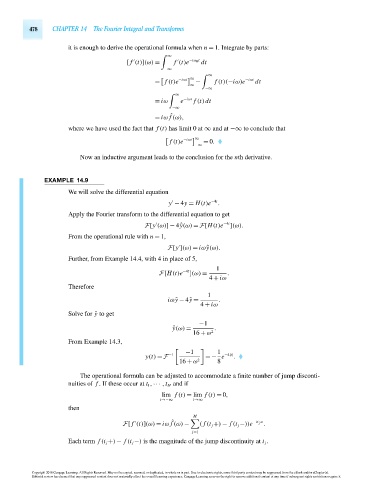Page 498 - Advanced engineering mathematics
P. 498
478 CHAPTER 14 The Fourier Integral and Transforms
it is enough to derive the operational formula when n = 1. Integrate by parts:
∞
−iω 0 t
[ f (t)](ω) = f (t)e dt
−∞
∞
∞
−iωt −iωt
= f (t)e − f (t)(−iω)e dt
∞
−∞
∞
= iω e −iωt f (t)dt
−∞
ˆ
= iω f (ω),
where we have used the fact that f (t) has limit 0 at ∞ and at −∞ to conclude that
∞
−iωt
f (t)e = 0.
−∞
Now an inductive argument leads to the conclusion for the nth derivative.
EXAMPLE 14.9
We will solve the differential equation
y − 4y = H(t)e −4t .
Apply the Fourier transform to the differential equation to get
F[y (ω)]− 4 ˆy(ω) = F[H(t)e −4t ](ω).
From the operational rule with n = 1,
F[y ](ω) = iω ˆy(ω).
Further, from Example 14.4, with 4 in place of 5,
1
F[H(t)e −4t ](ω) = .
4 + iω
Therefore
1
iω ˆy − 4 ˆy = .
4 + iω
Solve for ˆy to get
−1
ˆ y(ω) = .
16 + ω 2
From Example 14.3,
−1 1
−1 −4|t|
y(t) = F =− e .
16 + ω 2 8
The operational formula can be adjusted to accommodate a finite number of jump disconti-
nuities of f . If these occur at t 1 ,··· ,t M and if
lim f (t) = lim f (t) = 0,
t→−∞ t→∞
then
M
ˆ −it j ω
F[ f (t)](ω) = iω f (ω) − ( f (t j +) − f (t j −))e .
j=1
Each term f (t j +) − f (t j −) is the magnitude of the jump discontinuity at t j .
Copyright 2010 Cengage Learning. All Rights Reserved. May not be copied, scanned, or duplicated, in whole or in part. Due to electronic rights, some third party content may be suppressed from the eBook and/or eChapter(s).
Editorial review has deemed that any suppressed content does not materially affect the overall learning experience. Cengage Learning reserves the right to remove additional content at any time if subsequent rights restrictions require it.
October 14, 2010 16:43 THM/NEIL Page-478 27410_14_ch14_p465-504

